Originally published by the Saporta Report
Our last forests in and around Atlanta (The City of Trees) are under assault. Sites are needlessly being cut and scraped to further a suburban, conventional style development pattern that has consumed most of the woodlands and farms in and around Atlanta. We are left with a limited number of “forest enclaves” on the remaining private tracts of land, and they are awaiting a similar fate.
So, what can be done to turn this devastating trend around and save the majority of these remaining forested areas? Certain outstanding and unique forested areas can be preserved through special dedicated municipal or nonprofit funds – but what of all the other sites?
Trying to stop “growth” is not a likely option. Cities and towns need to maintain a viable tax base and a balance of real estate development while providing housing and workplaces
What we need is a different approach to real estate development. A way forward to develop land that is competitive financially with conventional development, preserves the majority of our forested areas, re-integrates urban farms and brings people together around a renewed connection to the land with nature and farm based activities. A method that clusters the development into walkable village and hamlet clusters while preserving the majority of the green space on site and connecting to adjacent preserved green spaces.
We call this development approach a Village Conservation Community. It’s an age-old traditional form of development that was the norm prior to the advent of the automobile and suburb, though it was not called that at the time.
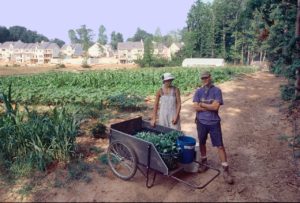
At East Lake Commons, the use of the village conservation concept preserved space for a community garden. Credit: Village Habitat Design
Our company, Village Habitat Design, has been planning and promoting this type of development since our first village conservation community, East Lake Commons, 20 years ago. The project consisted of 67 homes in village cluster placed on 40% of a 20 acres site, it preserves 60% of the site as woodlands and a farm that has provided produce for the village for the last 20 years, Gaia Gardens.
In order to promote substantive conservation of the remaining infill green spaces, Village Habitat Design recommends the following conservation metrics:
- Urban Sites: preserve a minimum of 20% of the buildable site area;
- Intown Sites: preserve a minimum of 50% to 60% of the buildable site area;
- Suburban Sites: Preserve a minimum of 60% to 80% of the buildable site areas;
- Rural Sites: Preserve a minimum of 80% to 95% of the buildable site areas.
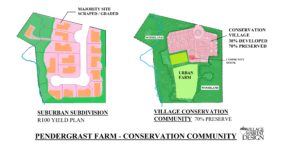
These two drawings illustrate the results of a traditional development plan (left) and (right) a village conservation community that preserves 70 percent of the existing site. Credit: Village Habitat Design
Pendergrast Farm Conservation Community is to be developed as a current model for this type of infill development on one of the last remaining forest enclaves on Briarcliff Road in DeKalb County. On a site located at 3398 Briarcliff Road, Village Habitat Design and Earth Craft home developer Dennis McConnell are collaborating on Pendergrast Farm Conservation Community. The groundbreaking is expected in Spring 2022.
The 8.7-acre Pendergrast Farm is clustering 20 units of residential development into a 2.6-acre village cluster and preserving 6.1 acres – 70% of the property as woodland and a 1 acre urban farm. The property was rezoned from R100 (large lot suburban) to a site plan specific village cluster and conservation area.
The “cut and scrape” diagram illustrates the difference between the mass grading required for R100 large lot suburban zoning and the limited “scrape and grade” for the Village Conservation Community cluster. In the R100 diagram the lots are a minimum of 15,000 square feet in size while in the conservation village cluster the lots vary from 3,000 to 6,000 square feet, enabling the preservation of the 6.1 acre preserve. This preserve will function as a community land trust and will be protected by a conservation easement.
Key components of the Pendergrast Farm Conservation Community will include the following:
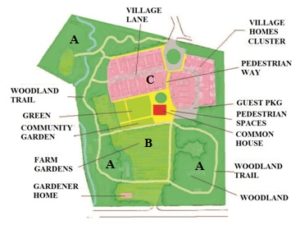
Pendergrast Farm is to be developed with houses in the areas shaded pink, and the remaining tract is to remain as woodland and greenspace. Credit: Village Habitat Design
6.1 acre preserve
70% of the site at Pendergrast Farm will be preserved with a conservation easement with an opportunity for additional conservation of adjacent forest areas to create a contiguous forest canopy corridor. Conservation community development often initiates the preservation of contiguous green space. Plans call for:
- Urban Farm: Part of the 6.1 acre preserve will be a 1acre farm that will produce vegetables, fruits and eggs for the Pendergrast Farm residents and participating neighbors within walking distance. In addition, the farm will provide events and farm-based education programs. Biodynamic farm practices will rebuild healthy soils as well as compliment the natural habitats with pollinator gardens and other natural farm-based habitats;
- Solar Village: A 20-unit solar village with homes that are high energy performing (Earthcraft homes) will create the potential for a net zero energy village.
Land Preserve Governance:
The 6.1 acre preserve, (owned by the Pendergrast Farm HOA) will use a community land trust model to manage the preserve. Pendergrast Farm preserved will be accessed by the Pendergrast Farm home owners as well as surrounding neighborhood residents living within walking distance that chose to become members of the Pendergrast Farm land trust;
This will enable land trust members to interact in a variety of farm and nature-based programs for school aged children up to seniors. This land trust membership-based community model has been developed over the years to reinforce community interaction / participation and responsible use of the land;
The advantages of this Village Conservation Community model are four-fold: Conservation of land, community benefits, pedestrian priority and development incentives.
Conservation of Land
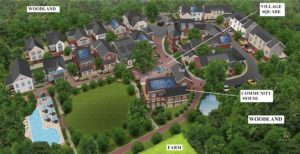
The village concept of the planned Pendergrast Farm development is to cluster homes together and retain the remaining land as woodlands and greenspace. Credit: Village Habitat Design
The conservation incentives are apparent: Keeping the “scrape and grade” impact to a minimum and preserving the majority of the site for woodlands, urban agriculture, recreation and expanded stream buffers.
Additionally, conservation community can incentivize adjacent landowners to create opportunities for larger offsite open space connections.
Community Benefits
The existing neighborhood benefits from larger buffers placed between existing homes and the new development and access to the nature and farm-based amenities. Future homeowners benefit from a place oriented development with:
- Easy walking distance to woodlands/farm gardens, farm to table dining and recreation;
- Little or no yard maintenance (streets, common areas and optionally private courtyards are maintained by the HOA landscape services);
- More opportunities to explore hobbies in the community maker space and potential for home and neighborhood based workplaces;
- The knowledge that their children can be free to safely explore nature and walk or ride a bike to visit neighbors;
- Food and energy resilience through farm fresh produce subscriptions and efficient Earthcraft solar homes.
Pedestrian Priority
The community is designed to be pedestrian priority with internal “Woonerf Streets” (designed as a shared street for slow moving vehicles and pedestrians). Portions of the street and the village plaza are pedestrian only use protected by bollards and most of the homes face walking paths in the woodlands and on the farm.
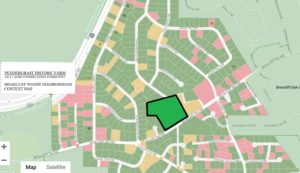
Pendergrast Farm is to be developed on a tract of land along Briarcliff Road, southwest of Northlake Mall. Credit: Village Concept Design
Development Incentives
Developers benefit from marketing advantages, infrastructure savings, a unit bonus and zoning. and permit incentives that include:
- Marketing advantages accrue from the desire of buyers for smaller, easier to maintenance lots and homes overlooking and within easy access of preserved woodlands, urban farms and recreational opportunities. The combination of a more diversified product, smaller lots and downsized homes permits a broader price range making the final product more marketable as well as more compatible with neighborhoods and their housing needs.
- Infrastructure advantages accrue from clustering homes and can save 15 to 25% of infrastructure costs compared to sprawling lots across a site.
- Unit bonus benefits accrue because conservation lots are significantly smaller than suburban styled lots. The potential for adding 10 to 30% more conservation lots to the development achieves lot value equivalency between the larger suburban lot zoning and the small conservation lots implementation – insuring a very competitive development as compared to conventional development.
- Zoning advantages: Neighborhoods have a much higher likelihood of supporting Village Conservation Communities due to the increased buffer between the new development and their existing homes and the preserved lands with trail access to farms and woodlands.
In closing, woodland and farm based village conservation communities such as Pendergrast Farm are not only good for existing neighborhoods, future residents and developers, but they also create tremendous resilience and hope in a world facing uncertainty regarding climate change, loss of bio-diversity, pandemics and social dis-connectedness. This model can protect nature, provide urban farms ,food and energy resilience, reduce stress on infrastructure, improve health through walking and connection to nature and help incubate small neighborhood businesses.
To implement additional conservation communities, we urgently need to change the conventional car and sprawl based development model and incorporate Village Conservation Community zoning opportunities.
Note to readers: Greg Ramsey is a founder, principal and chief of design for Village Habitat Design.
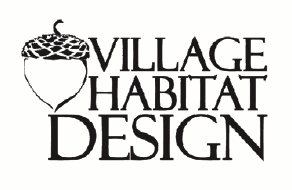
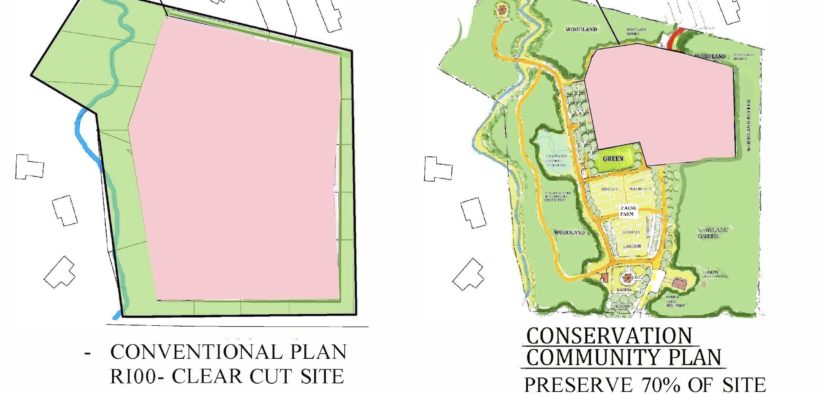

We are a non profit organization that works with returning citizens. We are also interested in projects that are holistic, and can provide services in the areas of health, housing and employment. These initiatives are very interesting and i would like to know more about what’s involved. We are an organization, with limited development experience, but we can assemble a team to pursue an important like this.